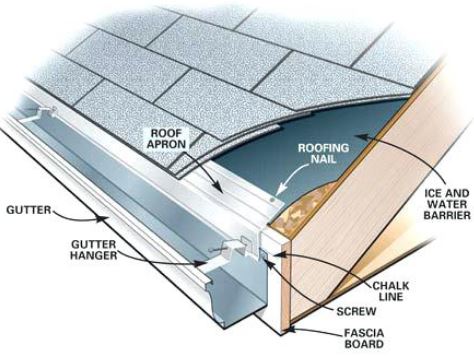Abstract: North Shore and Sunshine Coast Home Inspector notes on house systems, what to expect when they approach their end of service life and how to budget for their replacement.
When installing a new roof, it is best to budget for gutter replacement at the same time. Here’s why. We are going to consider three issues associated with re-roofing and good construction practices:
- Inter-dependent roofing material should have similar life spans or at least easily replaced components.
- Make use of a drip edge along the roof line to guide water flow into the gutter.
- Confirm the condition of the facia board and replace if necessary.
Inter-dependencies
Inter-dependent systems should have similar life expectancies. Standard asphalt roofing materials have an estimated life expectancy of roughly 15-20 years. Aluminum gutters have an estimated life expectancy of 15-20 years. Therefore when replacing a asphalt roof it makes sense to replace the aluminum gutters at the same time. There may also be some discounts available to the homeowner if the roofing contractor is associated with a gutter contractor.
Roofing Materials
Metal roofing is a premium home product, you can expect your new roofing to cost roughly two to three times what an asphalt shingle roof costs. Metal roofs are known for their longevity and can last 40-60 years. Copper gutters can last for 50-60 years. Ideally then a metal roof should be matched with a similar long-lasting gutter material. However copper gutters can cost 2-4 times that of aluminum and also make a strong visual statement. If this is not of interest to the homeowner, metal roofs can be used with aluminum gutters but it means that these gutters will have to be replaced twice over the lifetime of the metal roof. If the existing gutters are reused, then the gutters might have to be replaced 3 times over the lifetime of the roof, say at the 5, 25 and 45 year anniversary dates.
Drip Edge
One of the most common omissions in re-roofing installations is not installing a metal drip edge. A superior installation contractor will include a metal ‘L’ shaped drip edge, nailed to the roof sheathing, which extends 1-2 inches vertically down over the wood facia. Here we pre-suppose that the facia board itself is competent and not damaged by rot. Its purpose is to make sure that rainwater is channeled into the gutter and not back under the roofing material or onto the wood facia. Make sure that your roofing contract includes this drip edge in the quotation! It is certainly possible to install this drip edge into the existing gutter, but it may require cutting notches into the drip edge to go around the gutter’s nailed supports that connect the gutter to the facia.
Facia
Be sure to check with the roofing contractor to see if the facia is an important element of the installation. If so, then the condition of the wooden facia board should be good enough to last 40-60 years. If the existing gutters are reused, then the condition of the facia board is unknown and assumed to be in good condition. Any rotten or damaged sections of facia may just be spanned by the starter layer for asphalt shingles or closure strips used to match any manufactured ripple in a metal roof.
The facia is often completely hidden by the roofing material overhang and the attached gutter. When old gutters are removed, then the facia is exposed. Rotten or damaged sections can be easily replaced. The facia board is a simple element and replacement cost is minimal. Yet its important role as a roofing closure element and as a structural element for gutter attachment should not be underestimated.
In conclusion, always consider the impact and dependencies of interconnected systems when replacing any one element in any home renovation.

